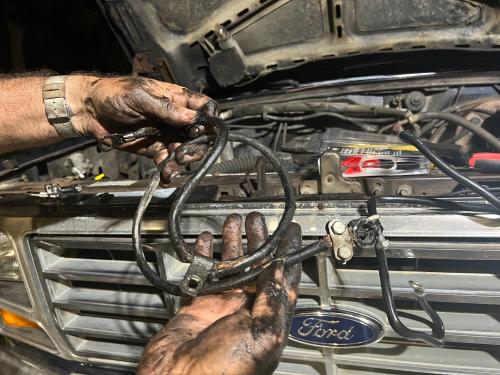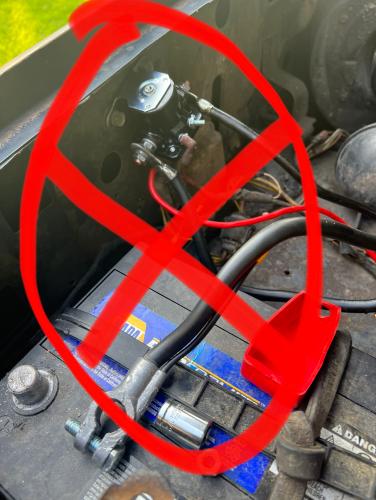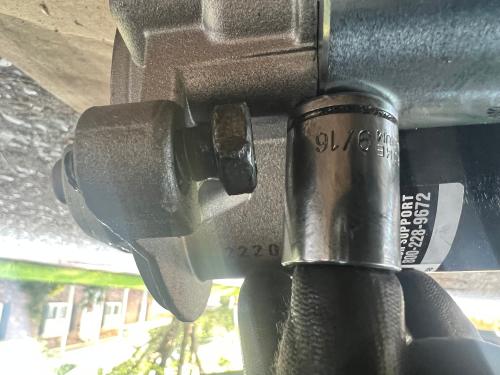Search Forum
Noobie Guide to Replacing Battery Cables, Starter Relay and PMGR Starter
|
This post was updated on .
The following is a detail of my first experience replacing the battery cables->Relay->Starter, along with an upgrade to the PMGR starter.
I bought this old 83 F150 5.0 because I thought it would be fun to learn. I like old trucks but have never done any work on them, past an oil change or a battery replacement. While there's good resources on the site about how to do much of this, I figured I'd detail my experience, from a noobie;s perspective. While the guys on the forum are super kind, they also tend to assume we all know more than we might, so I try to keep things really, really basic in this post, which is definitely the level I am learning from. One day in a parking lot, it just wouldn't start up. Popped the hood, looked at the batteries and saw that one of my ancient battery cable terminal ends was sitting in a pool of molten metal on top of the battery. Yikes. Poor connections create heat, heat melted the battery cable a bit... I tightened everything down, jumped the battery from a kind bystander and gave the key another turn, and was able to get back home, where I expected to change the battery cables and fix the problem. I'd never changed cables before but was assured that it wasn't hard. I bought a short 2 gauge cable for the positive terminal->relay, but I didn't find a longer negative battery cable with a "flag" (I didn't understand this term previously- it's a bare section of the battery cable with a bolt connection point midway down on it, for grounding the cable to the frame), so I bought two cables for the negative side, one to go from the battery to the engine, and a shorter one to place on top of that connection and go from the engine to the frame. The original battery cable had some plastic corrugated shielding on it, which I stripped and put on my new cable. (It would have been better to get a long section of larger gauge, new shielding- you'll see why down below) Note on changing battery cables for noobs: Pull your existing cables and measure them (or take them with you) before you go to the auto parts store. It's hard to envision how long you need when they're all snaked around in the engine compartment. I didn't do this, and so I ended up with too much cable, which works, but it's messy and the cables can get in the way of things (engine fan!). Once I am better at this, I will change the cables again to clean things up.  The positive cable from the battery to the relay is short and easy to change. The negative cable from the battery to the engine is long and (mine was, at least) very, very dirty and oily. I wished for gloves, and ended up buying some. The "flag" bolt was kind of hard to reach from the top of the engine compartment (you'll want a step stool to help you lean over the engine compartment). I didn't have a long extension on my socket wrench, so I combined two shorter extensions to make it easier to get the socket down there and still have enough space to turn the handle. At several points, I thought that a palm-sized socket wrench would not be a bad investment. Also- sorry- I didn't write down what sized sockets were needed for this part of the job. I did a lot of trial and error and fumbling around with sockets and oily hands, which is frustrating, especially from inside the engine compartment or from under the truck. The negative -> engine cable connection was an underside job, which was also very dirty, but was not hard to access, really. Clean your new connection points as best you can with a rag and some degreaser before putting the new cables on. So, in the end I changed the battery cables and tried to start her up, but when I turned the key, the starter engaged, and then kept engaging and engaging and engaging, making a serious non-stop ruckus in my driveway, even after I turned the key off and took it out. Pulled the battery cables off the terminals to make the horrible noise go away. Another tip: don't tighten your battery cables down on the terminals until you're sure you're done with any job, cause you might need to pull them off quickly if something goes wrong. Since I obviously needed to start replacing things down the starter chain, I consulted with my father in law and learned a little bit about starter relays. Probably the relay was bad from the heat/stress the bad cables put on the system. And maybe the starter was bad, too. But- start with the relay. Went to AutoZone and got a Durabrand starter relay. I know lots of folks only like the NAPA gold parts, but AutoZone is my closest supplier and i like the old guy who manages it and I'm not experienced enough at all this to have tons of personal preferences between parts.  A fender mounted relay is super easy to replace. Assuming things were hooked up correctly previously, just take a pic before you pull the cables off, and then put them back the same way they were. These helpful diagrams are from this excellent resource page from Gary Lewis.  Relay replaced, the starter engaged (and also disengaged)- but still didn't roar to life and didn't sound right. Jumped my truck battery from my wife's car in case the battery was a little weak, took the chargers off and checked the battery charge, pretty much confirmed that the truck battery should be fine to start up.  On to replacing the starter. Once you've replaced a starter, you can do it quickly, but since this was my first time, it took a while. Adding to the complexity, I decided to upgrade to the later PMGR starter, (which is described in the resource I linked above). It isn't stock for the bullnose models, but I understand that it is a better starter for several reasons. Lots of bullnose guys on here prefer them. Only thing is, it requires some rewiring from the relay, which can be confusing for noobs like me. Here's the diagram for the wiring, if you want the PMGR starter upgrade.  The linked article is great, but Im not good at electrical, or reading diagrams, apparently, and still messed it up. More about that later. Also- If you just want the stock 80's starter- you can just pull off what you have, replace it and put everything back the way it was. I maybe should have gone that route since I'm a noob but I learn the hard way. Went to AutoZone and asked for a starter for a 93 F150 5.0, since that F150 year used the PMGR starters, and I was assured that it should bolt on just like the old starter did. Two bolts and some wiring. I think the PMGR starters are often supposed to be much smaller and lighter than the original starter in the 83, but this version wasn't actually much shorter or lighter. Take your old starter to the store when you buy the new one, (or take it there after you change it, with the receipt), and they refund you something like $40 for the metal that's in the core.  You'll also want to buy a new #8 or #10 gauge battery cable- At my AutoZone there was a #8 universal battery cable package that is long enough, and comes with connection rings that fit the relay and starter terminals nicely. Notes on wiring: The short, fat, positive cable from the battery terminal to the big lug on the front side of the relay stays where it was (connected to the front, always hot side of the relay). The new #8 gauge red cable you just bought connects to the big lug on the far side of the relay, which it the side that only lets come pass electricity to the starter when the relay is activated. There used to be a big fat #2 or #4 gauge cable going from the far side of your relay to the 80's style starter. Now, that connection moves to the near side (the always hot side). Push the loose ends of those cables down to about where the old ones went, and you can grab them on the underside. If you are smart enough to buy some wire shielding ( I dont know the proper name for this), you'd do well to cover up the fat black starter cable and the new red #8 cable down together in a cable shield, so they stay neat and protected. When you're done wiring at the relay, it looks like this (don't connect your battery yet!):  AND- UNDER NO CIRCUMSTANCES SHOULD IT LOOK LIKE THIS:  If you do that, you've got it wired backwards, and in 10-15 seconds after connecting your battery you will fry your starter, and maybe everything else. I did that, and I fried my brand new $200 starter, smoke billowing and swearing and frantic battery cable pulling and all. Thankfully, there's no video available. Ok- about underside access to the starter- I don't have a lift, and I don't have ramps. I also didn't want to jack the truck up and get under it. Would have been easier but I'm just not super experienced and didn't trust a bottle jack, really. So, I did all this in my driveway, worming my way under the truck. If you're any bigger than me (6foot, 210lbs), you might not fit. Also- get some cardboard to lay on- and a headlamp. I also put on my reading glasses cause Im almost 43 and suddenly cant see the numbers on the sockets very easily. If not glasses, you'll want safety goggles, cause dirt and rust and maybe oil falls in your eyes the whole time, unless your 80s model truck is WAY cleaner than mine. ALSO- you probably did this earlier but you really want to make sure that you disconnect any cables from the battery terminals before screwing around with these cables under the truck. It's easy to forget, and super dangerous. The two main bolts on my starter housing needed a 9/16 socket.  You'll want a long extension, or two short ones stacked, on the socket wrench. You're welcome.  Pull the original starter off and you'll have a hole that looks like this:  Clean the grime off of it with a rag and maybe some grease remover before installing the new one. Place the new starter in that hole and bolt it in, top bolt first with your fingers so you don't drop it on your face, then once you've got the bottom bolt finger tight, you can tighten them both down with the socket wrench. In my experience, there was only one configuration that would have worked, as far as installing the starter the right way up. Ive heard of dudes installing them wrong, but I don't see how they could have done it. Connect the original thick black starter cable to the large top terminal on the starter (in this case, the one that doesn't have any blue paint on it). This brand starter had a pigtail for connecting the solenoid to the relay, which I eliminated and just connected the red #8 cable instead, after cutting six inches off of the cable that I didn't need, and then putting the connection ring on and crimping it down with pliers. This model starter used a 13/32 socket for the nut on that connection.  All done, the starter wiring looked like this:  Once you're done with that, double check that your connections are correct (say a prayer for my first fried starter), and then connect your battery and start her up! Hope this is helpful- feel free to ask questions or critique/correct me if Ive put something on here wrong. Like I said, I'm a bullnose noobie (but less of one every day)!
TJ McCloud
Lil'Blue:1983 Ford F150 4x4 Standard 5.0 302 V8 C6 3 speed automatic DS-II Ignition 2150 Carb |
Re: Noobie Guide to Replacing Battery Cables, Starter Relay and PMGR Starter
|
Administrator
|
Well done, TJ! Good writeup!
I'll admit I'm having to wipe my eyes 'cause I'm laughing so hard I'm crying. For instance I remember all so well telling my granddaughter yesterday that her father's arms were getting shorter. She looked "that look" at me and then started laughing when she understood. (It was almost at that same time that my phone lit up, yet again, from someone laying under an '83 asking questions and I couldn't answer 'cause I was having too much fun.) But I'm glad you got the starter bit worked out. I'm sure it is cranking much faster now with that PMGR starter. The 2nd one. 
Gary, AKA "Gary fellow": Profile
Dad's: '81 F150 Ranger XLT 4x4: Down for restomod: Full-roller "stroked 351M" w/Trick Flow heads & intake, EEC-V SEFI/E4OD/3.50 gears w/Kevlar clutches
|
Re: Noobie Guide to Replacing Battery Cables, Starter Relay and PMGR Starter
|
This post was updated on .
In reply to this post by tjmac
TJ, I assure you that you’re not alone here!  LOL! You remember Christmas family parties, when you were kid, listening to the adults conversations all around and trying to understand what they were talking about? I often feel this way, while reading at some forum posts, more often when they look to be written in some strange Morse code (Tranny, Dizzy, ECU, EEC, DSII, PMGR, TTB, and so on).  Hopefully, we’re no more in Enigma’s era, and googling this mysterious "secret code" usually gives good decryption results. What a satisfaction when you finally decode the conversation! It has no more to do with magic or the occult, you now understand, yeaaaaah…  The guys on this forum are really cool with newbies, they are patient, take us by the hand, saying «oookay, kid, me/explain/you». I love this place, I feel free to ask ‘stupid’ questions, knowing that the Masters will take time to slowly elevate my knowledge. Please, continue to share your "noobie" experiments, you have a funny humorous style and… no need to google, that’s nice! 
Jeff / 1984 F350 Crew Cab 4x4/5.8L w351 4V/ T18/ D50 4.10 front/ 8' bed.
Restored 2019-2022. Nicknamed «Big Brother 1984», due to its soooo-looong shape & nod to George Orwell's 1984 famous novel. |
Re: Noobie Guide to Replacing Battery Cables, Starter Relay and PMGR Starter
|
In reply to this post by tjmac
 That's the ground cable I installed a while back.  There's how the battery is normally located.
1986 F150 302EFI AOD
|
Bullnose Enthusiasts Forum
›
Resources & How-To's
|
1 view|%1 views
| Edit this page |

